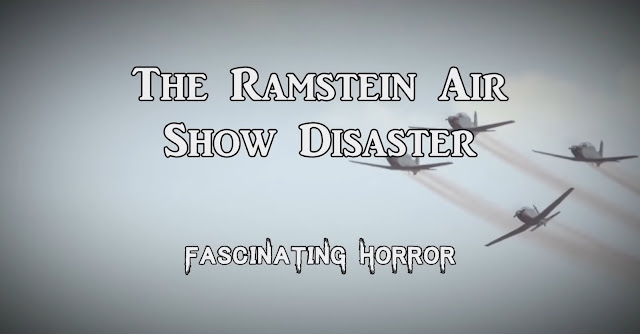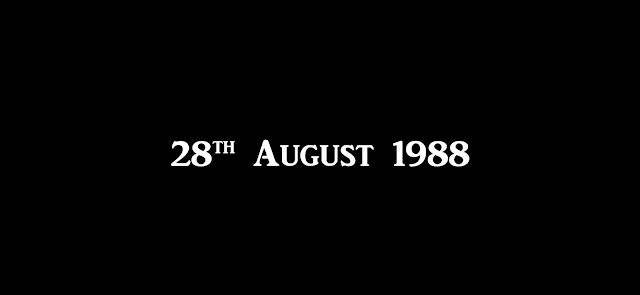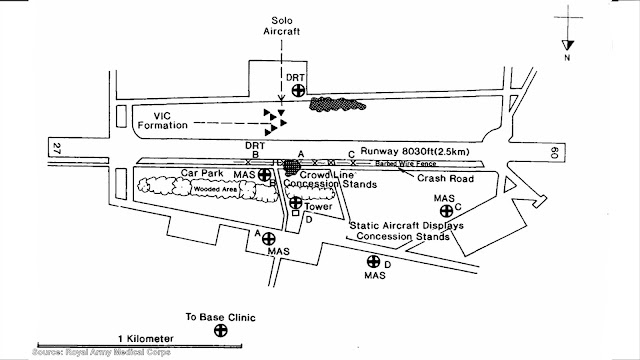Fascinating Horror - On the 28th of August, 1988, 300,000 people gathered at the US Air Force Ramstein Air Base in Germany to watch an air show featuring a demonstration by the Italian Air Force.
During the performance, a mid-air collision would result in what
was at the time the deadliest air show disaster in history – the emergency
response to which would highlight a fundamental breakdown in cooperation
between the US and German authorities.
Background
In the aftermath of World War II, the USA decided that, due to rising tensions with the Soviet Union, they would need a greater air defence presence in Europe.
They wanted to move their vulnerable fighter units away from East
Germany.
As part of a NATO expansion programme, France agreed to offer
space in their zone of occupation in West Germany, in Rhineland- Palatinate.
Construction of the Ramstein Air Base began in April 1948, near
the city of Kaiserslautern, and it was opened on the 1st of June 1953.
Complete with family housing, headquarters, schools, cinemas,
administrative offices, and a commissary, it was a massive air base covering
over 3,000 acres.
It was originally made up of two separate bases, The Ramstein Air
Station and the Landstuhl Air Base, but these were joined together after the
German government constructed the A6 Autobahn which completely cut off access
to the main gate of the Landstuhl base.
This was seen by some as an example of the ways in which the
German and American authorities often failed to communicate.
Meanwhile, in 1961, the Italian Air Force created a department
whose specific purpose was to form a national aerobatic team - the Pattuglia
Acrobatica Nazionale Frecce Tricolori.
They replaced unofficial teams that had been performing since the
1930s, and were the largest aerobatic patrol in the world.
A famous part of their display was to trail green white and red
smoke in a representation of the Italian flag – an appropriate symbol given
that part of their name - Tricolori, or “Three colours” – was a reference to
the flag.
Only the best pilots, with more than 1,000 flight hours, were
chosen to be part of the Frecce Tricolori.
Despite this, and the fact that the squad was purely
demonstrational, it was still a very dangerous job.
Within the first six months of the department’s existence, there
had been four accidents, with two members of the team dying as a result.
Another famous formation was known as “The Pierced Heart”.
To complete this manoeuvre, two groups of aircraft flew in
opposite directions to form a heart shape, which was then pierced by a lone
aircraft.
The Ramstein Air Base Disaster
During the afternoon of Sunday the 28th of August, 1988, a huge crowd of 300,000 people had gathered at the Ramstein base to watch the Frecce Tricolori.
Air shows had become a huge fundraiser for the base.
Some of the units located there were, in fact, deployed for the
day working on ice cream trucks to help raise money from the vast crowds.
The weather on the day was perfect for flying - clear and sunny.
The Frecce Tricolori began their demonstration and performed
several complex manoeuvres to the general delight and admiration of the crowd.
It was all building to the climatic performance of The Pierced
Heart.
The manoeuvre initially went well.
Two groups of planes formed a heart shape in the sky above the
airbase, approaching one another for a close pass at the lower point of the
heart at 3:44pm.
The plane that should have subsequently “pierced” the heart,
however, approached too low and too fast.
Before the two groups of planes could clear one another, this
plane, the call sign of which was “Pony 10”, smashed into them at high speed,
just 45 metres (or 150 feet) above the ground.
Three aircraft were involved in the collision.
Pony 10 crashed into the runway below, exploding into a violent
fireball and showering the watching spectators with burning fuel and debris.
The largest parts of the plane came to rest against a refrigerated
ice cream trailer.
Meanwhile, one of the other aircraft that Pony 10 had hit crashed
directly into a medical evacuation helicopter that was parked on the ground.
The third aircraft exploded in the air, raining down more debris
on the crowd below.
Several planes remained in the air, having narrowly escaped being
involved in the collision.
They regrouped and flew to Sembach Air Base, around 30 kilometres
(or 19 miles) away.
As they left the area, the situation on the ground was chaotic.
The crowd had been showered with debris, killing 28 people
instantly.
Two of the three pilots involved in the collision had died on
impact.
The third had managed to eject, but his parachute had not opened
and he had also died when he hit the ground.
American firefighters and ambulance personnel arrived on the scene
just two minutes after the collision.
It became quickly apparent, however, that the US vehicles (which
usually only served the base itself) did not have sufficient medical equipment
to cope with a disaster of this scale.
Calls were placed to German emergency services, but ambulances
that were despatched were held up at the entrance to the base.
German vehicles were not normally allowed to enter, and it took
some time before permission could be obtained to allow them entry to attend to
the wounded.
German medivac helicopters started arriving at 4:10pm, but it was
nearly an hour after the collision, before enough ambulances had arrived to
treat the injured.
The delay in getting adequate resources to the site was also
compounded by the chaotic nature of the immediate response.
A doctor who was present at the time later recalled the scene: “We
are searching for burnt patients that are pulled and transported unaided away
from us by the Americans… Not all the injured people are transported away by
helicopter or ambulance.
There is total chaos around us and some of the injured are even transported on pickup trucks that are not leaving (via) an emergency exit, they are driving beside the drifting visitors.” The confusion wasn’t limited to the scene.
The German authorities still had little idea of the scale of the
disaster even an hour after the collision.
One medic on site later described the confusion: “It was not
possible to find an officer in charge, a director of operations or even a
contact person… Asking several action forces, paramedics, police officers
nobody could name a director of operations.
I was asking for a managing paramedic of the operation to coordinate the evacuation. But there was none.”
Many patients were rushed off the base by American personnel, who used wooden planks rather than waiting for stretchers, and carried patients in trucks or other vehicles rather than waiting for ambulances.
While this allowed casualties to be transported more quickly, it
also meant that they could not receive treatment during transport… and, worst
still, American drivers who were unfamiliar with the area risked taking a
circuitous route or transporting patients with severe injuries to the wrong
hospital.
Equally, hospitals which had been given little information about
the disaster, were unable to prepare for the influx of severely injured
patients.
A German paramedic later reported the conditions they found at one
nearby medical centre: "When I arrived in Landstuhl, severely burnt people
lay on wooden planks and no paramedics were there.
After I aided an injured person and left her with a hospital nurse that attended us at the flight, I was treating several injured people at the helicopter landing zone at the military hospital and did not see even one American medic there."
At 6:30pm a bus full of injured people (including some with severe burns) arrived at a hospital in Ludwigshafen, around 80 kilometres (or 50 miles) away.
There was no paramedic present, just a non-German-speaking driver
that did not know the area, and had spent hours desperately searching for a
hospital.
In all, 67 spectators and three pilots died in the accident, and
500 people required hospital treatment.
The Aftermath
In the aftermath of the disaster, questions were asked both about the initial cause of the accident, and the response to it.
Why had Pony 10 come in so low and so fast for the final part of
the Pierced Heart manoeuvre? While some theorised that it could have been due
to a technical issue or even sabotage, there was no evidence to support this.
The most likely cause of the accident, it was concluded, was pilot
error.
The response from the US military and the German civil authorities
was criticised.
Investigations revealed that, for much of the accident, it was
completely unclear who was in charge.
Communication throughout was extremely poor – sometimes relying on
amateur radio operators who happened to have been at the air show to transmit
vital messages.
The US military prioritised transporting patients over providing
first aid, and in many ways German and American protocols were so different
that a unified response was impossible.
Many air shows across Europe were cancelled in the wake of the disaster,
and it was three years before another air show of the same scale would take
place in Germany.
During that time rules were put in place to establish a much
larger minimum distance between aerobatic displays and crowds, and manoeuvres
oriented toward any crowd were banned outright.
Because of these changes, air shows across Europe are
significantly safer than they were before the disaster.
Today there stand two memorials to the 70 people that lost their
lives as a result of the disaster – one accessible to the German public just
outside the west gate of Ramstein Air Base, and a separate memorial inside the
base itself.
SOURCES:
- "Ramstein 1988: Death falling from the clear blue sky" by P Huber, published by Austrian Wings, August 2018. Available via: https://web.archive.org/web/20180901145758/https://www.austrianwings.info/2018/08/ramstein-1988-death-falling-from-the-clear-sky.html
- "Aug. 28, 1988: Ramstein Air Show Disaster Kills 70, Injures Hundreds" by D Dumas, published by Wired, August 2009. Link: https://www.wired.com/2009/08/0828ramstein-air-disaster/
- "West Germany Hellfire from The Heavens" by James O Jackson, published by Time, September 1988. Available via: https://web.archive.org/web/20070318005720/http://www.time.com/time/magazine/article/0,9171,968416,00.html









Post a Comment
Post a Comment